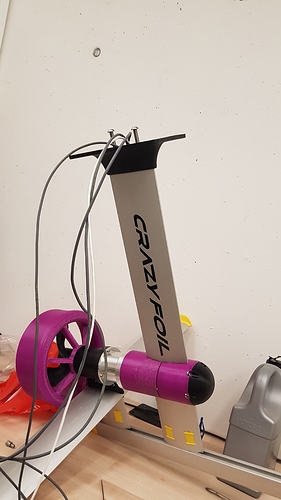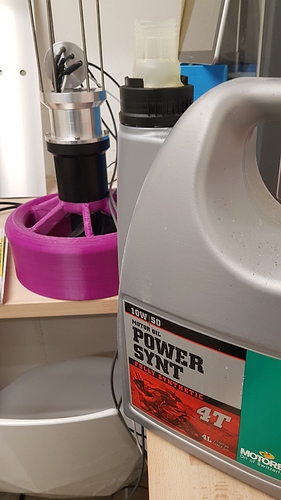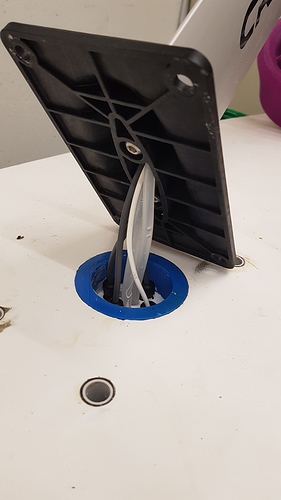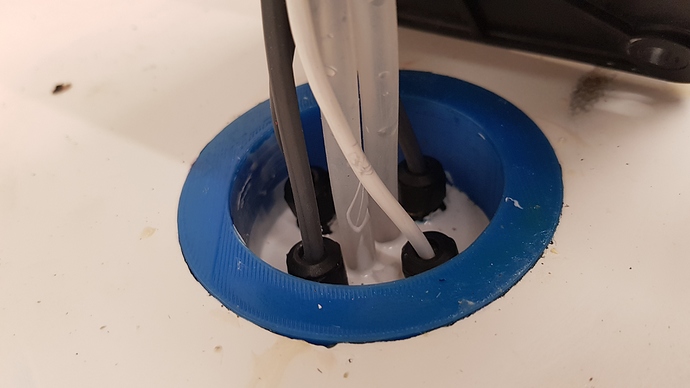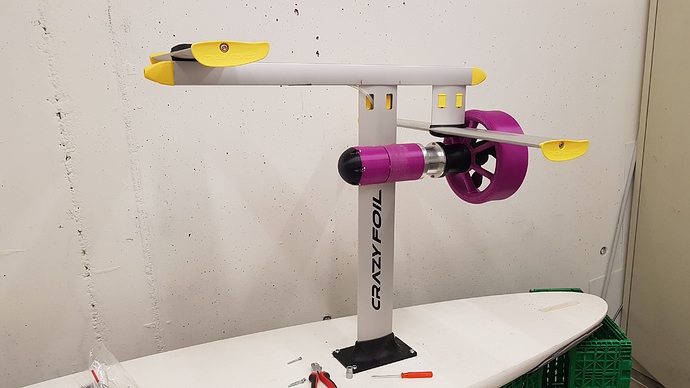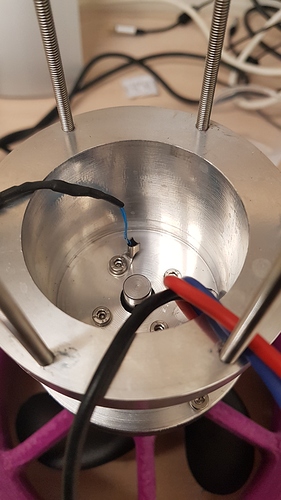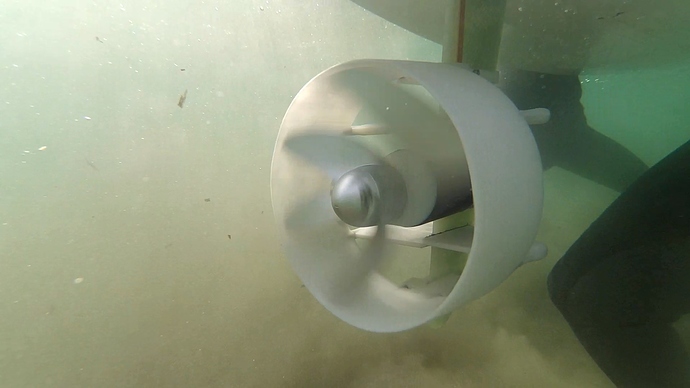I decide to open this section to groupe all experience and project concerning a direct drive with outrunner
Update of my experience/project
Battery: 8s
Esc: alienpower 300amp watercooled
Motor: alienpower 3.3kw cooled by oil, 130kv
Propeller: solas 7.25 x 6"
Foil and mast: from crazyfoil to begin
Loose in air running:80w
Loose in water running:140w
Loose in oil running: 180w
And you, what is your experience, good or bad!?
Hi @Vincentbraillard. It’s great to see your research on this topic. I too did some wet outrunner tests back in July when I saw what the ROV community was doing:
- Sealing stator and magnets: https://forum.openrov.com/t/epoxy-filling-method-for-brushless-motors/1875 and http://www.efipolymers.com/applications/electrical-potting/motors/
- Replacing bearings with ceramics or plastic bushings like http://www.igus.com
I didn’t run it in oil like you but directly in the sea water. I found this 60kv Outrunner and gave it a try. I didn’t bother with the corrosion preventing steps above yet, I took it as is, I wanted to see if/how it works first. I flushed out the salt water with alcohol after testing.
In general running outrunners wet works great but my 60kv motor just had not enough power. I might have been able to tune the prop a bit more but I figured I was a bit too far off from the required power with this setup…and then I got sidetracked with other things. But I love the simplicity of this setup. Motor and 3 printed pieces (prop sitting on the can, mast mount front and back), no cooling issues, no seals, no aluminum tubes. Super simple. Getting it corrosion proof and powerful enough is the challenge. Certainly worth continuing to explore with more powerful outrunners - please keep us posted!
Here a short video documenting a test: https://youtu.be/B-rKpB7w4To
Thank you very for your feed back!
At work I use allot of electronic and electromechanical systems that are pressure balanced oil filled and we use a light mineral oil about 5wt. This includes motors up to about 30 KW.
Anyways I think you will have better results (less drag) from something lighter than 10w50 motor oil. Off the shelf mineral oil would be better.
I was planning to do this also but am actually considering using a different fluid.
I am considering: Polypropylene glycol, silicone brake fluid, and very light 0w10 motor oil.
One other thing is that oil expands more than you realize when when it heats up. Its best to have some kind of pressure compensator. This is often done with a simple barbed fitting screwed into the housing connected to a piece of tygon tubing a couple of inches long and plugged on the end. I have seen oil filled housings blow the seals when they aren’t compensated.
We occasionally have issues with hardening of wire insulation as a result of incompatibility with the oil in particular from PVC based plastics so if possible use wire thats teflon sheathed.
Hello
Thank you very much for your feedback.
Concerning your comment for the 10w50 oil you are right. It was just fir test purpose but I have a crew to remove oil and replace it when I want. I will take 0w10 if I can find some!
But I quite surprise with the lost. Only 100 watt more compare to a motor running in air…with oil 10w50! That’s very good
Hi Guys! Can you please explain how the system keeps the oil within the motor, so it doesn’t leak when the motor is spinning in high rotation (5000rpm), so it is not mixed with the sea water?
Bether on this website:alienpower
Here is the oil I am planning on using. https://www.searspartsdirect.com/part-number/u197-8a/0042/390.html
Just got it in a few days ago. Not sure about the weight of it. It doesnt say anything on the package. Just from shaking it around in the bottle it seems pretty thin. Maybe a bit thinner than like 5 weight motor oil. I chose this oil for its dielectric properties. I was concerned that running anything else could cause a short across the motor coil connectors. It seems like @pacificmeister didnt have any issues with shorting out even running in seawater which is actually really conductive. I wonder though if perhaps you may have been losing some efficiency with the possibility of current bypassing the coils and shorting through the water? Do you mind sharing what motor you used for your test @pacificmeister?
As far as pressure compensation goes @colin you bring up an important point. My current plan is to only fill the motor housing about 80-90% full of oil to allow some compressible air to remain in the housing to compensate for the oil expanding as it heats. I plan to mount the motor unit to the ladder in my pool and perhaps using a clear acyrillic tube in place of the aluminum tube for some of the first (short) tests to see how the oil behaves. It will be interesting to see how aerated it gets with the air in there and how that will affect viscosity. Hopefully it wont act like whipped cream in there!
I realy do like this your concept…
It seems to me that lack of power is not due to motor but due to impeller - it seems that not too much flow…
did you measure max amps while running this construction in water?
yes, 27amps while kneeling on it and full throttle
with 12c battery? then it is about 1,3 kwt -about half of max power for this motor…
I made some experience with outrunners 6374 and 6384 with 130kv from Alien. I used a 120A ESC, which blew the first motor. I use Epoxy 4 hour cure time in combination with a fridge compressor for processing vacuum to seal the stator. The rotor is hydro optimated. I use stainless bearings with ceramic balls and sealings.
With the 120A ESC i get good results when trying to glide on a F2 Stratos.
The problem is electrical windings end somewhere in the stator foot and its hard to get them electrically insulated fully. The original windings are interfaced there to 2mm^2 flexible wires. From there is another solder interface to single lead copper wires moulded into the fin. Tightened with Plastic70, a spray lacquer for insulation.
From the foot of the fin i have a flexible 3 phase 6mm^2 cable going over the rear of the board to the box seated on top in front of the driver.
Thank you so much for your feed back! Have you more pictures?
I have no fully understand if at the end, it has work or not.
Your first motor burn? Right? And what about the seconde one?
Can you tell us more about the type of propeller and battery?
Thank you
The second survived so far. The prop is the cheapest you can get, no name, 180mm diameter, i cut it down to around 160 on a lathe. The other parts are milled, 3D printing could also work. The first motor was hydrodynamical opimized, that was a failure.
Keep the epoxy coating thin. The seconds motor had more space between the windings, so cooling is much more effective. I run it in the mediterrainian sea, very salty.
The incomplete insulation at the interface makes it necessary to insulate anything else with IP68 or better, so there is no current through water where a person could be.
E.g. the so called safety switches have the problem, that they are not really insulated between inside contact and outside ambient, they only have a cheap and ineffective rubber cap, scrap. Tried to find a better one, talked to some experts, no positive feedback so far.
Battery box with BMS ZLA13, TF02N Shunt, Albright Relay, VESC-X and 32Ah 12s mounted in a frame.
Oh…so great. With so much battery you should drive a lot of time!
I have the following configuration, not yet tested!
Alien .otor 130kv 3.3kw
Alien esc 300amp water cooled
8s/20ah battery
Solas prop 160mm with 6"pitch
Foil: crazyfoil
Motor run in oil who is cooled by conduction
Can you tell me what do you think about my setting! It could work?
Thank you
I did not get it, which motor are you using?
Alien 6374 HEV Outrunner brushless motor 170KV 3300W
I’ve just started testing a Leopard 160kV motor with a Solas 7 1/4 x 6 prop. I went with a larger diameter motor to help cope with the torque required to turn this prop. At 36 Volts it pulled about 105 Amps static thrust. Soon I plan to test to see if the amps drop off quickly as the craft speeds up and the propeller unloads; I’m hoping it does.
I am using this with sucess http://alienpowersystem.com/shop/brushless-motors/aps-6384s-sensored-outrunner-brushless-motor-130kv-4000w/ removed the sensor board. Travelling with estimated 12 or 15km/h using 2.4kW from Battery on windsurfboard without foil, velocity dropped after a minute or two, vesc stepped in by temperature degradation down to 1.2kW and held there for an hour. Sometimes pauses to cool down and have full thrust again. The box is not specially cooled and i have no plans to do so. Instead i plan to have the inner temperature rising 30°C above the surrounding temperature, which is normally rather cool at the water surface. By this i calculate up to 200-400W power dissipation through the walls of the battery box. Additionally i load the temperature capacity of the batteries by warming them up. When charging, i open the box and ventilate.
haha, strange concept, due to the fact i have a leakage at the motor and cannot accept any additional linkage from the box. And honestely i do not want to remove this leakage as it can only affect a small area, because all surroundings are plastic. Anyhow, how can i guarantee or prove, that the motor is electric insulated, and what do i do, when it is sending a warning always.
When you go testing, take it easy. Keep the Duty Cycle low, try not to overload, learn something before its broken and hang on, stay at site … Good luck ![]()
